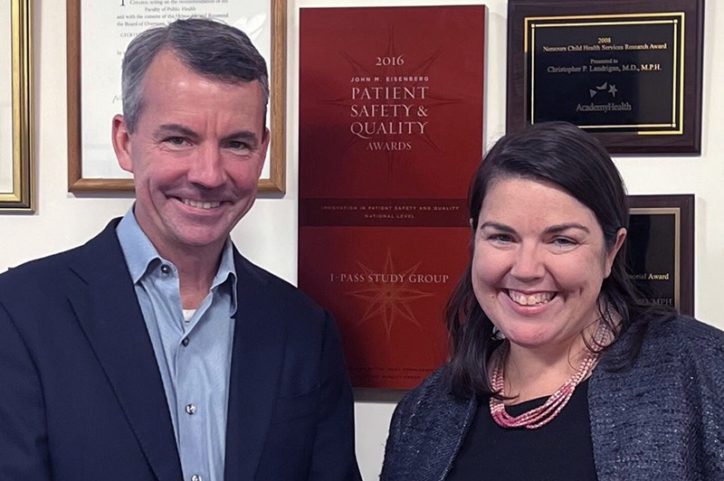I-PASS this patient to you: Improved hospital ‘handoffs’ cut adverse events by almost half

About 15 years ago, Boston Children’s Hospital pediatricians Christopher Landrigan, MD, MPH, and Amy Starmer, MD, MPH, observed a weak link in hospital care. Medical residents were rigorously trained to take patient histories with standardized templates and to present cases in a structured format during daily rounds. Yet such structured communication was largely absent at a critical time: during shift changes when patients’ care was handed off to new providers.
“Patients who are admitted to the hospital typically have multiple teams of providers caring for them, so these periods of information handoff occur frequently throughout their stay,” says Landrigan, now chief of the Division of General Pediatrics at Boston Children’s. “They are a common source of vulnerability for patients.”
Miscommunication contributes to about two thirds of serious adverse events in hospitals, according to the Joint Commission, a leading healthcare quality organization. And handoffs are especially prone to communication lapses. Providers finishing a shift may be tired and rushed and more apt to omit key information important to the patient’s care.
Wanting to improve this process, Starmer and Landrigan created the I-PASS Handoff Program. It consists of a package of communication and training tools that prompt providers to pass on crucial information — both verbally and in writing — in a reliable, structured fashion. In a study published in the Journal of Hospital Medicine last month, they put I-PASS to the test in a diverse group of hospitals. Results were striking: over a three-year period, adverse medical events were reduced by nearly half.
Capturing critical information
I-PASS revolves around a simple mnemonic that specifies information to be exchanged during handoffs:
I: Illness severity
P: Patient summary
A: Action list
S: Situational awareness/contingency planning
S: Synthesis of the information by the incoming provider
“We wanted to add structure to what was an unstructured and sometimes haphazard process,” explains Starmer, now associate medical director of quality in the Division of General Pediatrics.
In their first major study, published in The New England Journal of Medicine in 2014, Starmer, Landrigan, and colleagues implemented I-PASS at nine academic children’s hospitals. Following up, they found improved communication and a 30 percent reduction in serious, preventable medical errors. But would I-PASS work with adult patients and in other types of hospitals?
“We wanted to know whether the program would be similarly effective and feasible in a more ‘real-world’ setting, with for a broader variety of providers and patients,” says Landrigan.
The results exceeded their expectations.
A dramatic reduction in adverse events
The new study engaged 32 diverse hospitals — adult, pediatric, academic, and community hospitals. The researchers enrolled both residents and “faculty champions,” who are key to the successful adoption of I-PASS. They also provided outside coaching to help hospitals implement the program. However, to simulate real-world conditions, the I-PASS team provided much more limited financial and administrative support than in the 2014 study.
Supervising physicians at each hospital oversaw more than 3,000 patient handoffs before, during, and after program implementation and collected data. The I-PASS team separately reviewed 1,620 written handoff documents.
Analyzing error surveillance reports, Starmer, Landrigan, and colleagues found a dramatic 47 percent reduction in adverse events, both major and minor, after I-PASS implementation.
They also saw marked improvements in the completeness and quality of handoff communications:
- Verbal handoffs were complete in 66 percent of cases after implementation (up from 20 percent prior). Written handoffs were complete in 74 percent (up from 10 percent).
- Outgoing providers gave high-quality verbal and written patient summaries 81 percent and 78 percent of the time, respectively — up from 39 and 21 percent.
- Incoming providers gave a high-quality synthesis of the information they received 83 percent of the time versus 31 percent before I-PASS.
Going big with I-PASS
To the researchers’ surprise, improvements were consistent across the board — regardless of hospital size, setting, and patient population.
“Handoff is a universal issue in health care,” says Landrigan. “We think we’ve created a universal language for handoffs. The challenge now is to implement the program at scale across hospitals.”

Extending the reach of I-PASS will require some adaptations to accommodate different medical specialties. For example, the patient summary might be structured to include different elements for ICU nurses versus orthopedic surgeons. The ability to adapt the content within the broader universal structure helps to establish buy-in from providers.
To encourage the process, Landrigan and Starmer co-founded a startup company, the I-PASS Patient Safety Institute. The company is currently working with about 50 hospitals to launch handoff programs at scale, offering training, cloud-based tools, and support for medical records systems.
One encouraging sign: A year after this latest study was completed, the participating hospitals were still using the I-PASS approach. Many are working to expand the program to more care areas, focusing on more complicated handoffs that cross different care areas of the hospital.
“On the front lines, I-PASS still takes an input of effort and a willingness to change behavior,” says Starmer. “That’s where support and investment of resources and time are important. But it’s been interesting watching the field evolve. Fifteen years ago, there was much more resistance. But now, there’s recognition that handoff communications are important to safety. Hospitals are increasingly focused on ‘high reliability’ and standardizing their operations, and I-PASS aligns perfectly with that focus.”
New I-PASS directions
Starmer and Landrigan are also translating the I-PASS concept to clinician-family communications through a 21-center study that’s now wrapping up. With Alisa Khan, MD, MPH, they are also developing strategies for communicating with families who have limited comfort with English and are at increased risk for medical errors. And Starmer has had success translating I-PASS to improve patients’ transitions from ambulatory care environments into the hospital and vice versa.
“This project has been near and dear to our hearts,” says Landrigan. “It’s exciting to see I-PASS grow and gain traction from its seeds 15 years ago and filter into different parts of the health care system.”
Landrigan is co-founder, board member, and scientific advisor for the I-PASS Patient Safety Institute. He has equity in the company and receives compensation for his scientific advisor role. Starmer is a co-founder and consultant for the I-PASS Patient Safety Institute. She has equity in the company and receives compensation for her consulting role. Boston Children’s Hospital also holds equity in the I-PASS Patient Safety Institute.
Learn more about implementing I-PASS.
Related Posts :
-

Coronavirus: Ensuring patient and staff safety during the pandemic
As the coronavirus and COVID-19 infection continues to spread through the Boston area, we’ve heard many questions and concerns ...
-

Natural language processing captures new insights on patient safety
Safety monitoring at Boston Children’s Hospital is getting even more thorough, thanks to natural language processing systems. Aided by ...
-

Breaking down barriers: How interpreters can enhance patient care
Sharing medical concerns with clinicians can be hard for anyone — a challenge that’s amplified in patients when English isn’...
-

Improving developmental care for infants in the Cardiac Intensive Care Unit
Infants born with congenital heart disease (CHD) are some of the most fragile patients, often requiring surgery or other interventions ...





